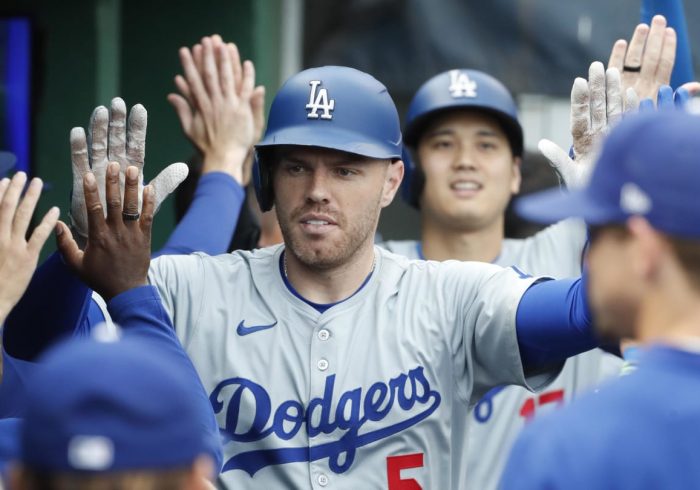Welcome to the Rookie Roundup, a weekly look-in on baseball’s best and most interesting first-year players. Last week, we checked in on under-the-radar rookie pitchers in the National League. This week, we’ll take a peek at American League squads currently floundering in last place in their respective divisions, and which rookies are providing the most hope for better tomorrows.
We’re now two months into the season, and by week’s end every team will have fewer than 100 games remaining on the schedule. That’s certainly more than enough time for fortunes to shift dramatically in the standings. But for a select few particularly dismal clubs, the writing is on the wall: 2024 just might not be their year.
For our basement-dwelling teams in the American League, now’s as good a time as any to start searching for silver linings. Let’s take a look at one rookie on each of the four last-place teams (we have a tie in the AL East) that’s providing reasons for optimism—maybe not for this year, but for the summers ahead, when hopefully the outlook is rosier than it is today.
All stats are updated through Sunday’s games.
Top rookie: Bryan Ramos, 3B
Ramos made his major league debut on May 4, and though he scuffled in his first taste of The Show (and has since been optioned back to the minors), the fact that he reached the big leagues at just 22 years old is reason to be hopeful in what’s been a truly terrible season for the South Siders.
Ramos is an all-around player who projects to be good in most areas but maybe lacks the high ceiling of the game’s blue-chip prospects. He posted an .826 OPS at Double A in 2023 and had six hits in four games since being optioned to Triple A last week. He’ll almost certainly be back with the big-league club at some point this season given that the White Sox are on pace to lose over 120 games.
Top rookie: Rafael Soriano, RHP
Chicago’s historically abysmal start has overshadowed what’s been a miserable season for the Angels. Mike Trout hasn’t played since April 29 and will likely miss at least a couple more months, and the team sits in last place behind an Oakland A’s team that many expected to be among baseball’s worst.
Los Angeles has several rookies on the active roster, in no small part because of the organization’s woeful lack of depth necessitating quick promotions. As a result, players like Nolan Schanuel and Kyren Paris have struggled, though Soriano has provided a bright spot in the rotation. After originally signing with the Angels in 2016 at 17 years old, Soriano underwent two Tommy John surgeries during his minor league career before debuting in ‘23. He showed promise as a relief pitcher and has made the move to the rotation this season. Across 10 starts, Soriano has posted a 3.78 ERA with 51 strikeouts. His transition as a starter is beginning to pay off from a durability standpoint, as he’s logged at least six innings in each of his last three outings.
Top rookie: Curtis Mead, 2B/3B
The typically development-savvy Rays have fallen on hard times to begin 2024, posting the fourth-worst run differential (minus-53) in the American League. As such, there aren’t many impact rookies to choose from: outfielder Jonny DeLuca—currently batting .182—is the only rookie hitter on the roster, while Tampa Bay has had only 7 2/3 innings logged by rookie pitchers on the season.
Given that context, we’ll go with Mead as the Rays’ best source of hope. The 23-year-old posted a .900 OPS at Triple A last year to earn his first call-up, hitting a .253/.326/.349 across 24 games—not spectacular, but serviceable enough to earn himself a pair of starts in Tampa Bay’s two playoff games last October. He made the team’s Opening Day roster and struggled to find a groove at the plate, and the Rays optioned him to Triple A on May 6.
Since the demotion, Mead has picked things back up, posting a .262/.340/.459 slash line in 23 games. Given the commendable production from Isaac Paredes, Richie Palacios and Amed Rosario, it might take some attrition for Mead to get another shot at regular playing time. But continued improvement in the minor leagues would be encouraging for a player who seems to have a high ceiling.
Top rookie: Davis Schneider, 2B/OF
Schneider quickly became one of the best feel-good stories of the 2023 season in his brief big-league debut, and he hasn’t slowed down in ‘24.
Selected by the Blue Jays in the 28th round of the 2017 draft, Schneider wowed in a 35-game stint last year, posting a .276/.404/.603 slash line. He’s provided Toronto with strong production this season (134 OPS+) even after his BABIP has regressed from the unsustainable .369 it was in ‘23 to a more stabilized .305 this year. Schneider still strikes out a lot, but his 12.2% walk rate ranks among the league’s highest. The longer he maintains his current production, the more he’ll prove that last season’s breakout wasn’t just a flash in the pan.








